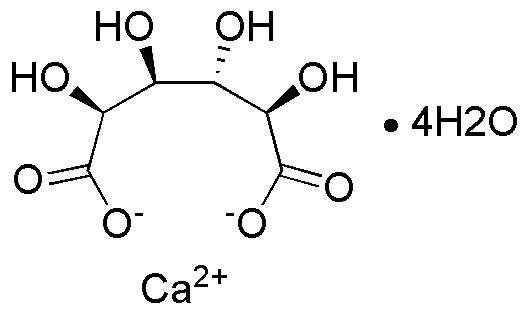Calcium D-saccharate tetrahydrate is widely utilized in research focused on:
- Food Industry: It serves as a food additive, enhancing flavor and acting as a stabilizer in various products, ensuring better texture and taste.
- Pharmaceuticals: This compound is used in drug formulations, particularly in the development of calcium supplements, providing an effective source of calcium for health benefits.
- Cosmetics: It is incorporated into skincare products for its moisturizing properties, helping to improve skin hydration and overall appearance.
- Biotechnology: In research settings, it acts as a chelating agent, aiding in the purification of proteins and enzymes, which is crucial for various biotechnological applications.
- Agriculture: Used as a soil conditioner, it improves nutrient availability and enhances plant growth, making it beneficial for sustainable farming practices.
General Information
Properties
Safety and Regulations
Applications
Calcium D-saccharate tetrahydrate is widely utilized in research focused on:
- Food Industry: It serves as a food additive, enhancing flavor and acting as a stabilizer in various products, ensuring better texture and taste.
- Pharmaceuticals: This compound is used in drug formulations, particularly in the development of calcium supplements, providing an effective source of calcium for health benefits.
- Cosmetics: It is incorporated into skincare products for its moisturizing properties, helping to improve skin hydration and overall appearance.
- Biotechnology: In research settings, it acts as a chelating agent, aiding in the purification of proteins and enzymes, which is crucial for various biotechnological applications.
- Agriculture: Used as a soil conditioner, it improves nutrient availability and enhances plant growth, making it beneficial for sustainable farming practices.
Documents
Safety Data Sheets (SDS)
The SDS provides comprehensive safety information on handling, storage, and disposal of the product.
Product Specification (PS)
The PS provides a comprehensive breakdown of the product’s properties, including chemical composition, physical state, purity, and storage requirements. It also details acceptable quality ranges and the product's intended applications.
Certificates of Analysis (COA)
Search for Certificates of Analysis (COA) by entering the products Lot Number. Lot and Batch Numbers can be found on a product’s label following the words ‘Lot’ or ‘Batch’.
*Catalog Number
*Lot Number
Certificates Of Origin (COO)
This COO confirms the country where the product was manufactured, and also details the materials and components used in it and whether it is derived from natural, synthetic, or other specific sources. This certificate may be required for customs, trade, and regulatory compliance.
*Catalog Number
*Lot Number
Safety Data Sheets (SDS)
The SDS provides comprehensive safety information on handling, storage, and disposal of the product.
DownloadProduct Specification (PS)
The PS provides a comprehensive breakdown of the product’s properties, including chemical composition, physical state, purity, and storage requirements. It also details acceptable quality ranges and the product's intended applications.
DownloadCertificates of Analysis (COA)
Search for Certificates of Analysis (COA) by entering the products Lot Number. Lot and Batch Numbers can be found on a product’s label following the words ‘Lot’ or ‘Batch’.
*Catalog Number
*Lot Number
Certificates Of Origin (COO)
This COO confirms the country where the product was manufactured, and also details the materials and components used in it and whether it is derived from natural, synthetic, or other specific sources. This certificate may be required for customs, trade, and regulatory compliance.


